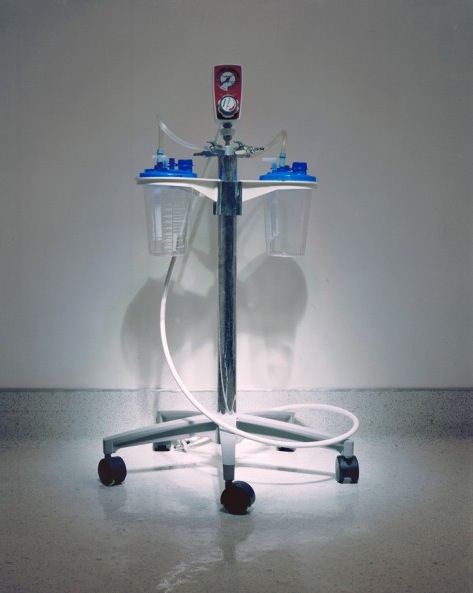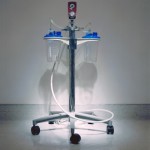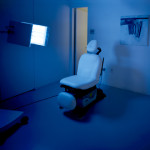Developed as a series of medical procedures to correct for abnormalities, cosmetic surgery has transformed into an industry to manage what nature has denied. Advanced techniques for plastic surgery were developed after World War I to restore function and symmetry to wounded veterans. Medical aesthetic management is a product of modernity, and offers contemporary society the promise of beauty by knife. This statement is an observation, since collectively we engage so many personal aesthetic enhancements, whether it is by whitening toothpaste or topical moisturizers. However, when function or health is not a pressing issue, betterment is an internal quest, shaped by real, or imagined, external pressures. The act of augmenting one's appearance is a private matter, eventually displayed in a public forum.
-
Cara Phillips' series of photographs, Singular Beauty, on display at Suffolk Art Gallery, focuses on the interiors and the tools used in the cosmetic surgery industry. Phillips' descriptions of these businesses are formally photographed as plainly as though they might be for a catalog. They are frontal, informational, and devoid of activity. Though, these spaces are lit like a theater production, and the objects within them shift from the mundane to the fantastic.
Interestingly, the theatrical lighting is built into the design of the spaces to enhance the illusion of transformation, as though one has now become part of their own custom production. These interiors are an illusion of surfaces that include veneer, decals and paneling. Depending on one's point of view, these rooms are either a comic or tragic (or horrific) analogy for the services provided.
If these photographs contribute to the discussion of body politics, they are didactic by presentation, by the nature of what is left out. They are presented without any subtext on how this industry can transform people's lives, for better (or for worse). The utility of these tools are left to the imagination of viewers who may have no idea to what typical procedure entails beyond the tragic results on the cover of a tabloid magazine. The images symbolize drama by expectation of events to come (and in the way the their appearance lives up to the hyperreality evoked in cable shows like Nip/Tuck).
While a viewer might not reject the curious object (which is surreal, and therefore unknown), they might reject the context in which it is used, which is a moral judgment - one where a previous decision has likely already been made. For those that feel offended or disenfranchised by the images, they will find the photographs invalid. Though, there are those that will feel enabled, and Phillips' photographs will be seen as reverent to progress.
Phillips' work is nearly inseparable from this discussion, and its subject will always remain the elephant in the room. Beyond this, there is a secondary aspect of how photography has become intertwined with this topic. Were it not for the intense lighting, these photographs might look as bland as an insurance inventory. Were we not privy to its contextual use, these machines would be as nebulous as a common kitchen appliance studied closely. It is the context of their utility that prevents the close study of their design, and instead balances a fine line between curiosity and rejection. Again, the lighting it the active agent creating the dramatic effect, informed by the lighting conventions for cinema, and contemporary thriller/mystery/drama genres in television, not unlike the CSI morgue. These places in Phillips' images are like being immersed into a diorama where one is observed without an audience.
-
In the 1930's, glamor shots of Hollywood actors and actresses were photographed with similar lighting used in movie productions to enhance the talent's specific features, but were retouched to simulate the finish of statues. George Hurrell, a photographer for MGM Studios, would request that his subjects wear minimal makeup, because much of the stage cosmetics for that time appeared so artificial and flat in his photographs. He, along with his assistants, would hand retouch the processed negatives with abrasive tools then rebuild the image with with charcoal, and opaque masking fluid. The polished faces in his prints set a precedent for the surface qualities obtained today by dermabrasion, botox, and Lifestyle Lifts. Today, patients can appear already retouched, and feel relieved of judgment should they appear in an unsolicited photograph.
In an age of constant scrutiny and pervasive representation, people who have hyperaesthetic enhancement are, in a sense, retouched in expectation of photography. Many of these enhancements are exaggerated in casual exchanges, but appear normal, or necessary under the dulling effects of direct lighting. The makeshift photo studio cum anthropometric laboratory that are in the clinics exists not only to document the success of the procedures, but also to reinforce the atmosphere continual looking. One becomes aware of their being looked upon, and develops a sense of identity based on how others will be seeing them at a distance, or by surrogate snapshot.
As a footnote, the American Society of Plastic and Reconstructive Surgeons (ASPRS) was founded in 1931 as foundation for collective knowledge in the profession. In that same year, Surrealist painter Salvador Dali paints the Persistence of Memory, and Boris Karloff horrifies audiences as the Modern Prometheus in James Whale's adaptation of Frankenstein. These events highlight not only the hope of technological progress, and the simultaneous anxiety created in by loss of individuality (along with identity and control), in spite of that very same progress. This phenomenon extends into the present, and is exemplified by our varied reactions.
- Cara Phillips, Liposuction Machine #37, Beverly Hills, 2007.
- Cara Phillips, Before & After Room, Beverly Hills, 2007.
- Cara Phillips, Blue Laser Consultation Chair, New York City , 2006.
New England School of Art and Design at Suffolk University
"Singular Beauty" is on view until October 10th at the Suffolk University Art Gallery, located at 75 Arlington Street, Boston. All images are courtesy of the artist and NESAD.







